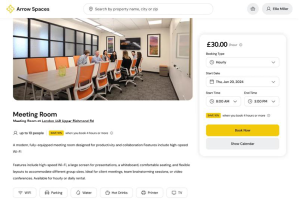5 Things to Consider When Selecting Technology Solutions for your Flexible Workspace
In his series of blogs with Justin Harley, regional director at Yardi, Tim Devitt explored Justin’s 5 top tips that operators should consider when selecting and implementing technology solutions to operate your flexible workspace.

1) Define a digital strategy
Ensure that you have a clear strategy that incorporates technology. Decide how and what you would like your experience to be for:
• Customers
• Staff
• Investors
• Supplier
This will help you develop a set of requirements that you will be able to articulate to potential suppliers. For example, when designing and fitting out your buildings incorporate connectivity requirements into the fit out. Your WiFi connectivity and customer experience will be impacted by your design decisions. This could cause blackspots of poor connectivity if you get it wrong that will adversely affect the client experience. Make sure your Wifi providers share their Wifi survey with your fit out provider so that Wifi access points are in the optimal position.
Great Wifi – You need to decide how and what you’re going to allow your clients to do about their own Wifi. Are you going to let them bring in their own WiFi or not? By allowing clients to bring in their own WiFi set ups, risks leading to increased WiFi interference which can impact service negatively across your other customers.
Managing data, GDPR & enhanced decision making – Finally, systems need to be interconnected and not set up in isolation. For example, when considering access control, do you require it to integrate with your management software? Are you considering a member app? If so, how will you provide your customers information on invoices, payments, meeting rooms if your systems are not interconnected?
Finally, get your suppliers involved as early as possible, the more you delay it the more costly it could be. Good planning prevents pitfalls.
2) Understand your customer journey & touch points
Work out your customer journey and key touch points, automate them and make them as seamless as possible so the customer doesn’t even know the technology is there.
For example, the initial tour of a space is a critical customer interaction, and the experience must be fantastic. Start the journey early so when they inquire, make that experience lovely, make it easy for them to make to enquire about your space. When they come for a tour, make the event into a world class experience. That includes booking the tour confirmation, following up after the tour and the physical tour itself.
Another example is the moving in experience and as with any moving experience it’s stressful for both the client and your teams. So how can you make that as seamless as possible? From making sure the room has been inspected and is in showroom condition to enhancing the move in experience by having their access cards are all ready for them when they move in and that they can log on to their network immediately.
Technology plays a role in all those things and ensuring all aspects of the technology are interconnected leaving less chance for service failure and more importantly consistency of service. So, what will be the key customer touch points that you may want to invest in?
3) Focus on the long term, invest up front and find a partner who will evolve as you do
Once you have determined your digital strategy and established your customer needs, you need to consider the long term aspect of the investment. To do this companies should consider the Total Cost of Ownership (TCO) of any technology and partnering with a system/provider who can support your business over the long term.
By taking this approach it gives a broader view of the investment and the value of the product over its lifespan rather than taking a short term view and only focussing on the set up costs.
The total cost of ownership looks at the cost of owning an asset in the long term by assessing both its purchase price and very importantly the additional costs of operation and keeping it updated. These additional costs often include new software, installation, transition costs, employee training, security costs, disaster recovery planning, ongoing support, and future upgrades. Get this right and it helps manage cost control and ensure ongoing high levels of service.
4) Work in partnership with your software provider to future proof the system
One of the top things to do when implementing technology is to align yourself with a provider who has a roadmap for installation and upgrades to adapt to advances in technology. It is also important that they can evidence a good track record of implementing and investing in technology and a question that operators should be asking their suppliers. When committing to a long term relationship, you want to know that your investment in a system and software that can evolve with developments in technology. Ask your provider how much they invest in developing the technology, how many developers do they have dedicated to the product, what percentage of sales is invested in R&D?
5) Invest in staff training
It’s one thing to have the latest technology, but you must have the staff trained to understand the process around every touch point to maximise the benefits. Successful implementation of technology is a mixture of process, technology, and the people. For example, you may have a company that says the business is all about the people, which is great, but unless you’ve got good technology, how can the people be efficient with customers unless you have the technology in place. In addition, if the people don’t understand the process and how to use the technology the service will also fail even with the technology in place.
Through quality training, staff learn the technology, understand the process and benefits, and learn to replicate the processes to deliver consistently high levels of service.
So, in conclusion some careful planning can help you implement the technology solution that will reduce your operating costs, assist in creating a great customer experience and help you make better business decisions as the data will always be available.




